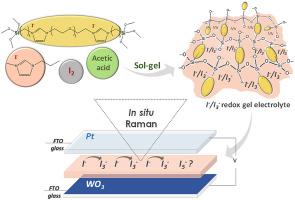当前位置:
X-MOL 学术
›
Sol. Energy Mater. Sol. Cells
›
论文详情
Our official English website, www.x-mol.net, welcomes your
feedback! (Note: you will need to create a separate account there.)
In situ Raman and UV–visible study of hybrid electrochromic devices with bis end-capped designed trialkoxysilyl-functionalized ionic liquid based electrolytes
Solar Energy Materials and Solar Cells ( IF 6.3 ) Pub Date : 2021-01-01 , DOI: 10.1016/j.solmat.2020.110863 Marija Čolović , Metka Hajzeri , Melita Tramšek , Boris Orel , Angelja K. Surca
Solar Energy Materials and Solar Cells ( IF 6.3 ) Pub Date : 2021-01-01 , DOI: 10.1016/j.solmat.2020.110863 Marija Čolović , Metka Hajzeri , Melita Tramšek , Boris Orel , Angelja K. Surca

|
Abstract Stable function of hybrid electrochromic devices (ECDs) is achieved by the application of quasi-solid-state redox electrolytes with high ionic conductivity and electrochemical stability. For this purpose, a polymeric gel electrolyte based on an imidazolium ionic liquid (IL)-functionalized siloxane network is prepared. First, a sol-gel processable, bis end-capped trialkoxysilyl-functionalized imidazolium-based IL is synthesized. The characteristics of the IL enable solvolysis and condensation on both ends of the molecule. In this way, the crosslinked IL forms a firm and brittle gel, as confirmed by IR and 29Si NMR analyses. The addition of iodine for I−/I3− redox pair formation does not produce a gel with sufficiently high ionic conductivity for ECD assembly. To obtain a more conductive gel electrolyte with an ionic conductivity of the order of magnitude 10−3 S cm−1, a nonreactive, 1-methyl-3-propyl imidazolium iodide IL is added as the cosolvent. These redox electrolytes with different concentrations of iodine are tested in hybrid EC devices for ~11,000 cycles. All the devices reveal an increase in lightness with cycling, either for the bleached or colored states, which occur due to gradual transformation of I5− to I3− and I− species. In situ Raman spectroelectrochemistry is applied to gain insight into the ECDs during 1250 cycles of functioning and enables the various iodide species to be differentiated.
中文翻译:

具有双封端设计的三烷氧基甲硅烷基功能化离子液体基电解质的混合电致变色器件的原位拉曼和紫外可见研究
摘要 混合电致变色器件 (ECD) 的稳定功能是通过应用具有高离子电导率和电化学稳定性的准固态氧化还原电解质来实现的。为此,制备了基于咪唑鎓离子液体 (IL) 官能化硅氧烷网络的聚合物凝胶电解质。首先,合成了一种可溶胶-凝胶加工的双封端三烷氧基甲硅烷基官能化咪唑鎓基 IL。IL 的特性使分子两端的溶剂分解和缩合成为可能。通过 IR 和 29Si NMR 分析证实,通过这种方式,交联的 IL 形成了坚固而易碎的凝胶。添加碘以形成 I-/I3- 氧化还原对不会产生具有足够高离子电导率的凝胶以用于 ECD 组装。为了获得离子电导率为 10-3 S cm-1 数量级的导电性更强的凝胶电解质,添加了非反应性的 1-甲基-3-丙基咪唑碘化物 IL 作为助溶剂。这些具有不同碘浓度的氧化还原电解质在混合 EC 设备中进行了约 11,000 次循环测试。所有设备都显示出随着循环的亮度增加,无论是漂白状态还是着色状态,这是由于 I5- 到 I3- 和 I- 物种的逐渐转变而发生的。原位拉曼光谱电化学用于在 1250 次功能循环期间深入了解 ECD,并能够区分各种碘化物。这些具有不同碘浓度的氧化还原电解质在混合 EC 设备中进行了约 11,000 次循环测试。所有设备都显示出随着循环的亮度增加,无论是漂白状态还是着色状态,这是由于 I5- 到 I3- 和 I- 物种的逐渐转变而发生的。原位拉曼光谱电化学用于在 1250 次功能循环期间深入了解 ECD,并能够区分各种碘化物。这些具有不同碘浓度的氧化还原电解质在混合 EC 设备中进行了约 11,000 次循环测试。所有设备都显示出随着循环的亮度增加,无论是漂白状态还是着色状态,这是由于 I5- 到 I3- 和 I- 物种的逐渐转变而发生的。原位拉曼光谱电化学用于在 1250 次功能循环期间深入了解 ECD,并能够区分各种碘化物。
更新日期:2021-01-01
中文翻译:

具有双封端设计的三烷氧基甲硅烷基功能化离子液体基电解质的混合电致变色器件的原位拉曼和紫外可见研究
摘要 混合电致变色器件 (ECD) 的稳定功能是通过应用具有高离子电导率和电化学稳定性的准固态氧化还原电解质来实现的。为此,制备了基于咪唑鎓离子液体 (IL) 官能化硅氧烷网络的聚合物凝胶电解质。首先,合成了一种可溶胶-凝胶加工的双封端三烷氧基甲硅烷基官能化咪唑鎓基 IL。IL 的特性使分子两端的溶剂分解和缩合成为可能。通过 IR 和 29Si NMR 分析证实,通过这种方式,交联的 IL 形成了坚固而易碎的凝胶。添加碘以形成 I-/I3- 氧化还原对不会产生具有足够高离子电导率的凝胶以用于 ECD 组装。为了获得离子电导率为 10-3 S cm-1 数量级的导电性更强的凝胶电解质,添加了非反应性的 1-甲基-3-丙基咪唑碘化物 IL 作为助溶剂。这些具有不同碘浓度的氧化还原电解质在混合 EC 设备中进行了约 11,000 次循环测试。所有设备都显示出随着循环的亮度增加,无论是漂白状态还是着色状态,这是由于 I5- 到 I3- 和 I- 物种的逐渐转变而发生的。原位拉曼光谱电化学用于在 1250 次功能循环期间深入了解 ECD,并能够区分各种碘化物。这些具有不同碘浓度的氧化还原电解质在混合 EC 设备中进行了约 11,000 次循环测试。所有设备都显示出随着循环的亮度增加,无论是漂白状态还是着色状态,这是由于 I5- 到 I3- 和 I- 物种的逐渐转变而发生的。原位拉曼光谱电化学用于在 1250 次功能循环期间深入了解 ECD,并能够区分各种碘化物。这些具有不同碘浓度的氧化还原电解质在混合 EC 设备中进行了约 11,000 次循环测试。所有设备都显示出随着循环的亮度增加,无论是漂白状态还是着色状态,这是由于 I5- 到 I3- 和 I- 物种的逐渐转变而发生的。原位拉曼光谱电化学用于在 1250 次功能循环期间深入了解 ECD,并能够区分各种碘化物。











































 京公网安备 11010802027423号
京公网安备 11010802027423号